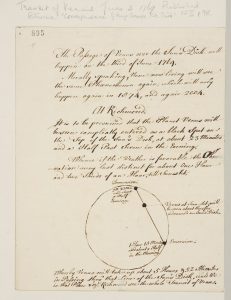RA GEO/MAIN/895: page 1
The transit of Venus is a rare but predictable astronomical event, which occurs in a pattern which generally repeats itself every 243 years, with pairs of transits occurring eight years apart. They are important events because when Venus, the Earth and the Sun are in a straight line, it is possible to measure the scale of the solar system by determining the distance of the Earth from the Sun. A transit occurred on 6 June 1761, and its ‘pair’ was due to occur on 3-4 June 1769.
George III had a great interest in the science of his day; his education had included physics, chemistry, and natural and experimental philosophy, and he developed a collection of scientific instruments, a number of which are now kept in the Science Museum. His fascination with astronomy led to his patronage of William Herschel in the 1780s and, in 1768, to his commissioning the architect William Chambers to build an observatory on Royal land at Richmond, London, in time for the transit of Venus the following year; the building still stands in the Old Deer Park, part of the grounds of the former Richmond Palace. The King stayed up to watch the event with a small group which included the instrument-makers John Cuff and Jeremiah Sisson, and the clockmaker Benjamin Vulliamy, and this memorandum estimates what was likely to be visible from Richmond of the planet’s progress.

